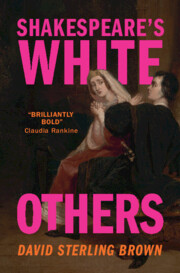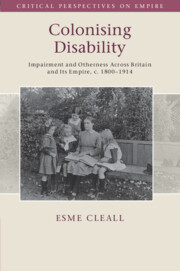33 results
Epilogue
-
- Book:
- Lucky Valley
- Published online:
- 11 January 2024
- Print publication:
- 22 February 2024, pp 416-445
-
- Chapter
- Export citation
18 - How to Make Use of Pagan Knowledge without Separating Oneself from the Church’s Milk: The Function of Otherness in Gregory of Nyssa’s Theory of Self-Perfection
-
-
- Book:
- The Intellectual World of Late Antique Christianity
- Published online:
- 05 October 2023
- Print publication:
- 26 October 2023, pp 328-346
-
- Chapter
- Export citation

Shakespeare's White Others
-
- Published online:
- 28 July 2023
- Print publication:
- 17 August 2023
Chapter 33 - Virtue on Robben Island
- from Part III - Shakespeare and Global Virtue Traditions
-
-
- Book:
- Shakespeare and Virtue
- Published online:
- 19 January 2023
- Print publication:
- 26 January 2023, pp 325-333
-
- Chapter
- Export citation
2 - The Metaphoric and Metonymic Conceptualisation of the Other
-
-
- Book:
- The Linguistics of Crime
- Published online:
- 05 January 2023
- Print publication:
- 05 January 2023, pp 16-38
-
- Chapter
- Export citation
1 - Editorial Introduction
-
-
- Book:
- The Linguistics of Crime
- Published online:
- 05 January 2023
- Print publication:
- 05 January 2023, pp 1-15
-
- Chapter
- Export citation
Introduction
-
- Book:
- The Greeks and Their Histories
- Published online:
- 01 December 2022
- Print publication:
- 15 December 2022, pp 1-9
-
- Chapter
- Export citation
The “Aliens” in Post-Yugoslav Cinema
-
- Journal:
- Nationalities Papers / Volume 52 / Issue 1 / January 2024
- Published online by Cambridge University Press:
- 31 August 2022, pp. 22-39
- Print publication:
- January 2024
-
- Article
-
- You have access
- Open access
- HTML
- Export citation
8 - Conclusion
-
- Book:
- Colonising Disability
- Published online:
- 21 July 2022
- Print publication:
- 04 August 2022, pp 246-251
-
- Chapter
- Export citation
12 - Monsters and Monstrosity
- from Part II - Genres
-
-
- Book:
- The Cambridge Companion to American Horror
- Published online:
- 21 July 2022
- Print publication:
- 04 August 2022, pp 183-198
-
- Chapter
- Export citation
1 - Disability and Otherness in the British Empire
-
- Book:
- Colonising Disability
- Published online:
- 21 July 2022
- Print publication:
- 04 August 2022, pp 25-61
-
- Chapter
- Export citation

Colonising Disability
- Impairment and Otherness Across Britain and Its Empire, c. 1800–1914
-
- Published online:
- 21 July 2022
- Print publication:
- 04 August 2022
1 - Opera and Italianità in Transnational and Global Perspective
-
-
- Book:
- Italian Opera in Global and Transnational Perspective
- Published online:
- 17 March 2022
- Print publication:
- 24 March 2022, pp 1-40
-
- Chapter
-
- You have access
- HTML
- Export citation
3.18 - Gothic, Neo-Imperialism and the War on Terror
-
-
- Book:
- The Cambridge History of the Gothic
- Published online:
- 29 July 2021
- Print publication:
- 19 August 2021, pp 364-382
-
- Chapter
- Export citation
Perception of otherness - the role of personality and demographic variables
-
- Journal:
- European Psychiatry / Volume 64 / Issue S1 / April 2021
- Published online by Cambridge University Press:
- 13 August 2021, pp. S372-S373
-
- Article
-
- You have access
- Open access
- Export citation
3 - The Autonomous Person
-
- Book:
- Private Selves
- Published online:
- 14 May 2021
- Print publication:
- 27 May 2021, pp 69-89
-
- Chapter
- Export citation
2 - The Immigrant As the ‘Other’
- from Part I - Making the ‘Other’ – The Construction of ‘Otherness’
-
-
- Book:
- European Societies, Migration, and the Law
- Published online:
- 13 November 2020
- Print publication:
- 19 November 2020, pp 19-42
-
- Chapter
- Export citation
14 - When a Country Is Not a Home
- from Part IV - ‘Othering’ in the EU
-
-
- Book:
- European Societies, Migration, and the Law
- Published online:
- 13 November 2020
- Print publication:
- 19 November 2020, pp 267-281
-
- Chapter
- Export citation
Chapter 1 - Magic and Otherness
- from Part I - Origins
-
-
- Book:
- Magical Realism and Literature
- Published online:
- 22 October 2020
- Print publication:
- 12 November 2020, pp 13-29
-
- Chapter
- Export citation
7 - Bereavement and the Meaning of Profound Feelings of Emptiness
- from Part II - Grief and Anxiety
-
-
- Book:
- Time and Body
- Published online:
- 30 October 2020
- Print publication:
- 12 November 2020, pp 125-143
-
- Chapter
- Export citation



